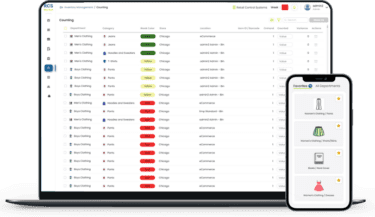Driven by a new wave of Gen Z demand, the second-hand marketplace has become the hottest sector in retail. Brands like Patagonia, Ikea, Vuori, and J. Crew have entered the resale market because they know the demand for second-hand is at an all-time high.
According to NARTS: The Association of Resale Professionals, 62% of Gen Z and Millennial consumers prefer to buy second-hand rather than new.
Yet many of these well-funded and sophisticated new players haven’t figured out how to efficiently manage inventory while new web-first models struggle to reach profitability. The second-hand market poses unique challenges regarding incoming inventory, and traditional retailers are simply not set up to handle large volumes of unique inventory.
Enter RCS Thrift Production Manager, a powerful tool that streamlines inventory intake for stores and chains with multiple location support.
Fast-paced businesses shouldn’t have to slow down for language barriers, so RCS has enabled multi language support to empower diverse teams in a business environment where English isn’t the only language spoken in the shop. Census Bureau data shows that in 2023, 36% of new business launches were Latino owned. The Thrift Production Manager seamlessly supports five different languages.
Inventory Management
 Thrift store owners and donated goods retailers know that taming the chaos of incoming inventory and profitably pricing it are the keys to a successful business.
Thrift store owners and donated goods retailers know that taming the chaos of incoming inventory and profitably pricing it are the keys to a successful business.
At thrift stores, incoming inventory often comes in the form of bulk caches of items, varying in quality and condition, where no two items are alike. Cataloging all these individually can be extremely time consuming, compared to the simple receiving work that takes place in other retail segments, where orders are pre-planned and organized by SKU.
RCS configures the Thrift Production Manager to create a fully customizable funnel that ensures a wide array of items can be quickly classified, labeled, and valued.
Say it’s a busy donation day during spring cleaning season, and all the local baby boomers have decided to downsize at the same time … and multiple truckloads of secondhand clothing and home goods arrive out of the blue at your thrift store.
Intake with the Thrift Production Manager is as simple as selecting the appropriate category, in this case “clothing”, then narrowing down through a fully customizable range of options. Let’s say our first piece is a pair of jeans. You simply click on “jeans,” choose women’s or men’s, select the size of the brand, and then assess their condition. Typically, this occurs on a good-better-best scale, but again, all fields are fully customizable.
Pricing & Labels
Pricing needs to be set before printing a label, and the RCS system is a huge improvement over other valuation methods in this area. Time constraints and varying levels of employee knowledge can lead to flat-rate pricing schemes that don’t differentiate between high fashion and fast fashion.
 Employees with wide-ranging fashion and business acumen can use the RCS AI pricing assistant to set a consistent baseline, taking the guesswork out of competitive pricing. While Goodwill stores are already using AI technology to ensure the authenticity of high-ticket luxury items, the RCS AI pricing assistant goes a step further.
Employees with wide-ranging fashion and business acumen can use the RCS AI pricing assistant to set a consistent baseline, taking the guesswork out of competitive pricing. While Goodwill stores are already using AI technology to ensure the authenticity of high-ticket luxury items, the RCS AI pricing assistant goes a step further.
The AI pricing assistant uses machine learning to scour the internet for similar items in similar conditions, providing a base-level frame of reference for pricing as well as passive learning for employees performing valuation. It takes into account brand recognition and current pricing trends, helping to ensure that pricing is both competitive and profitable. In the hugely variable world of thrift store inventory, the AI pricing assistant saves valuable research time and capitalizes on trends to maximize profit.
After setting a price, users can choose between various labeling protocols, including descriptive hang tags, QR codes, and standard bar codes. The label goes to the printer, then to the garment, and suddenly a new piece of inventory has been accurately entered, priced and tagged, all with just a few quick clicks.
On occasions when individual item entry isn’t necessary, say, when your store receives a bulk quantity of new tennis balls (or picture frames, or socks, or coffee mugs, the RCS Thrift Production Manager’s Bulk item entry feature allows them all to be priced and labeled simultaneously. This feature can be a game changer for flattening the curve of inventory spikes on big donation days.
All features of the Thrift Production Manager can be tiered to create distinct user roles for individual team members, all of whom operate under separate user profiles with individualized permissions.
Knowing what’s working and what isn’t is key to the success of any business, and RCS offers an array of reporting features including a powerful daily dashboard for real-time insights on business performance, inventory levels, pricing structures and employee performance.
